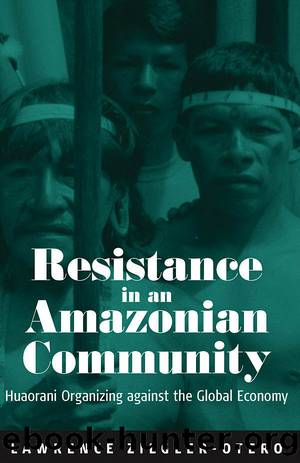Resistance in an Amazonian Community by Lawrence Ziegler-Otero

Author:Lawrence Ziegler-Otero [Ziegler-Otero, Lawrence]
Language: eng
Format: epub
ISBN: 9781845453060
Barnesnoble:
Publisher: Berghahn Books, Incorporated
Published: 2006-12-01T00:00:00+00:00
Land Titling: A Great Success?
One of the first and greatest successes of the organization was the legalization of Huaorani territory, which took place just as the organization was being born in 1990. This government recognition, however, did not come without cost. When ONHAE was formed, one of its initial demands was the legalization of its territory. The traditional range of the Huaorani people included the area known as the âProtectorateâ that had been controlled as a reservation by the Summer Institute of Linguistics prior to its expulsion. It also included a large unsettled central area and much of the Yasunà National Park. This park was designated by UNESCO as a âbiosphere reserve,â where oil exploration and extraction was prohibited. According to Thomson and Dudley (in Place 1993: 50-52), besides being home to the Huaorani, the Yasunà River drainage area is the ârichest in the entire region, containing fifty species of fish, five hundred bird species and over one hundred mammal species, including jaguar, ocelot, giant otter, freshwater dolphins, and at least ten species of primates.â
When ONHAE presented its territorial demands, the government of Ecuador, with great ceremony and remarkably little resistance, granted the Huaorani title to an area roughly the size of Puerto Rico, which represented a very large proportion of traditional lands and all of the known Huaorani communities. This transfer, made in April of 1990, gave the Huaorani the largest reserve of indigenous land in the country (see map). In making the territorial grant, the government carved out more than a third of the internationally recognized Yasunà National Park and transferred it to the Huaorani.
But there was a catch. When the transfer of title was made, the government simply retained all subsurface mineral rights, thereby making possible the exploitation of oil reserves in this area. Further, the government could award drilling, pipeline, and extraction permits without giving anything back to the Huaorani. As in most of the capitalist legal systems in the world, mineral rights may be sold independent of the land itself, and the owner of the mineral rights may not be impeded in efforts to extract the minerals. Immediately after granting the Huaorani the territory, the Ecuadorian government divided the area into numbered âBlocksâ and auctioned these blocks to the highest bidder. Under this arrangement, any attempt by the Huaorani to extract concessions from the oil companies operating in their territory or to impose a moratorium or an end to oil exploitation altogether, must rely on the moral force of their argument, for under settled rules of Ecuadorian and international law, they have no right or legal standing to interfere in the systematic alteration and destruction of their land caused by the extraction of oil.
By transferring the lands of the park in this manner the government had avoided much of the criticism that would have accompanied other means of permitting the oil development of Yasunà National Park. The government was able to claim that this transfer was occurring because of its concern and respect for indigenous rights, not primarily to provide for the exploitation of the oil reserves.
Download
This site does not store any files on its server. We only index and link to content provided by other sites. Please contact the content providers to delete copyright contents if any and email us, we'll remove relevant links or contents immediately.
| Argentina | Bolivia |
| Brazil | Chile |
| Colombia | Ecuador |
| Guyana | Paraguay |
| Peru | Suriname |
| Uruguay | Venezuela |
Cat's cradle by Kurt Vonnegut(15155)
Pimp by Iceberg Slim(14321)
4 3 2 1: A Novel by Paul Auster(12263)
Underground: A Human History of the Worlds Beneath Our Feet by Will Hunt(11997)
The Radium Girls by Kate Moore(11900)
Wiseguy by Nicholas Pileggi(5648)
Perfect Rhythm by Jae(5306)
American History Stories, Volume III (Yesterday's Classics) by Pratt Mara L(5239)
The Fire Next Time by James Baldwin(5224)
Paper Towns by Green John(5065)
Pale Blue Dot by Carl Sagan(4886)
A Higher Loyalty: Truth, Lies, and Leadership by James Comey(4822)
The Mayflower and the Pilgrims' New World by Nathaniel Philbrick(4403)
The Doomsday Machine by Daniel Ellsberg(4397)
Killers of the Flower Moon: The Osage Murders and the Birth of the FBI by David Grann(4368)
The Sympathizer by Viet Thanh Nguyen(4287)
Too Much and Not the Mood by Durga Chew-Bose(4256)
The Borden Murders by Sarah Miller(4216)
Sticky Fingers by Joe Hagan(4086)
